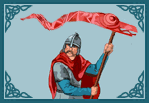 |
 |
|||
|
|
Prince Medraut is so tied up with Arthurian legend that it is difficult
to discern the real man. Early Welsh poetic sources tend to show him as
an heroic figure, rather than the villain and
enemy of King Arthur who appears in later literature. The
Trioedd Ynys Prydein or 'Triads of the Island of Britain' call
Medraut one of the three royal knights of the realm, noted for his wisdom
in peace and his ferocity in battle. He is most famous for his neutral
appearance in the Annales Cambriae which records "The
Strife of Camlann in which
Arthur and Medraut perished". This is the most reliable of the early
sources but might they have been fighting on the same side rather than
being the more traditional opponents? Perhaps not, for elsewhere in the
Trioedd Ynys Prydein, a serious quarrel is recorded between the
two, although full details are lacking as the story is not repeated in
other sources. Arthur certainly hit Medraut and
Guinevere also struck Medraut's wife, her sister, Guinevack
(more properly Gwenhwyfach). Medraut then took his warband to Cornwall
and invaded Arthur's palace at
Celliwig. He dragged Queen Guinevere from her throne and beat
her, before his party took to feasting and consumed all the food and
drink in the place. Arthur later retaliated in a similar manner.
It is Geoffrey of Monmouth who
first tells us that Medraut was a younger son of King Letan
of Gododdin (Lothian) and there are late Scottish traditions of him, largely
voiced by Hector Boece (1527). He portrays Medraut as a paragon of virtue.
Since Arthur was conceived out of wedlock, Mordred - as heir of King
Uther's only legitimate child, Anna - was the rightful King of Britain.
Arthur agreed to leave him the Crown but later reneged on the deal.
Furthermore, Queen Guinevere eagerly become Medraut's lover and deserted
Arthur to join him in Gododdin. Hence the two fought at the Battle of
Camlann. After Medraut's death, Arthur sent his wild hounds to Scotland
to hunt down his adulterous Queen. They caught up with her at Meigle
and ripped her to shreds. Medraut supposedly had two sons
and popular late tradition gives him a second wife, Princess Cwyllog, one
of the many daughter of the great Northern King Caw. She supposedly became
an anchoress at Llangwyllog on Ynys Mon (Anglesey) after the Prince's death,
but it is doubtful whether she actually existed. Certainly the true tradition
is that Medraut's wife was a daughter of the British King 'Gawolane' not Caw.
King Cadwallon Lawhir of Gwynedd may be intended. He should not be confused with Prince Medrod
the son of King Cawrdaf of
Fferreg.
Records of Medraut date back to the 10th century. He he generally considered historic. |
|||
| © Nash Ford Publishing 2001. All Rights Reserved. | ||||




